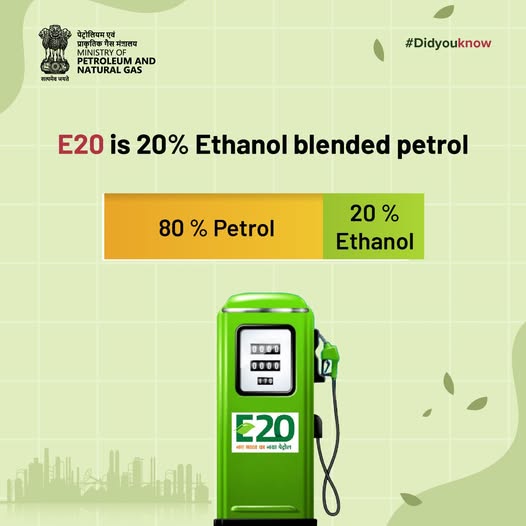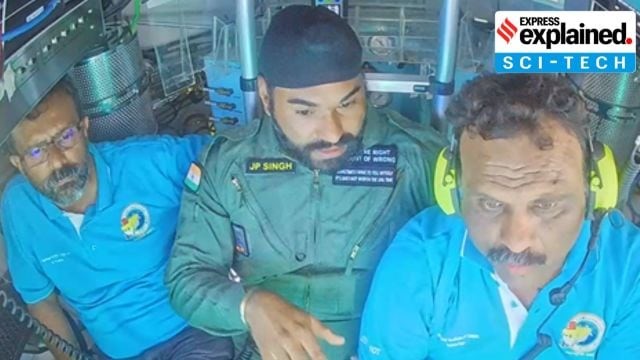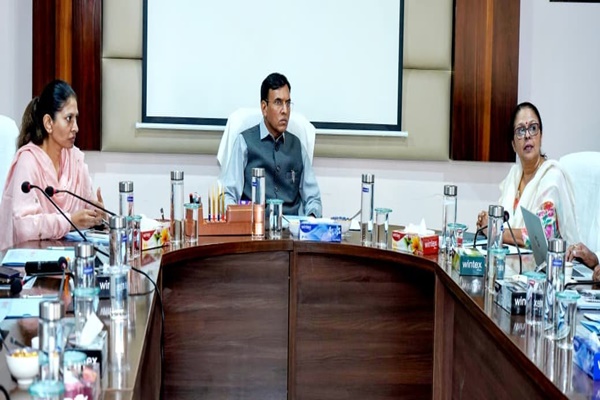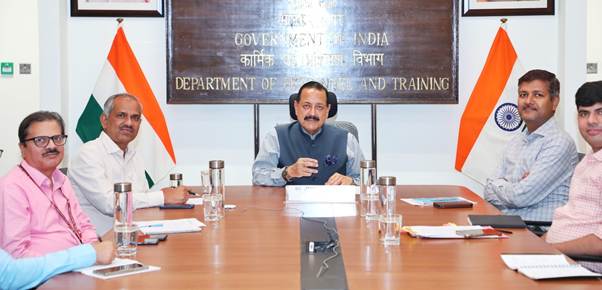Ethanol Blending in India

- 02 Sep 2025
In News:
India has been steadily advancing towards ethanol blending in petrol to reduce dependence on fossil fuels, cut carbon emissions, and boost the agricultural economy. Recently, debates have intensified after the nationwide rollout of E20 fuel (20% ethanol + 80% petrol) in July 2025—five years ahead of its initial 2030 target. Concerns were raised about its impact on older vehicles and consumer safety.
What is Ethanol Blending?
- Ethanol (C?H?OH): A renewable, biodegradable, and clean-burning fuel derived from biomass such as sugarcane molasses, rice, maize, barley, and wheat.
- Ethanol Blending: Mixing ethanol with petrol to increase oxygen content, leading to cleaner combustion, reduced greenhouse gas emissions, and lower crude oil imports.
- India’s Ethanol Blended Petrol (EBP) Programme began in 2003.
- Progress:
- 10% blending target achieved in 2021-22
- 12.06% in 2022-23
- 14.06% in 2023-24
- 20% blending achieved in July 2025, ahead of the 2030 deadline.
E20 Fuel and Automobile Industry Response
- E20 fuel is now being offered at petrol pumps, replacing earlier E5/E10 options.
- The Society of Indian Automobile Manufacturers (SIAM) confirmed that warranties will remain valid for older cars even if they were not originally designed for E20.
- Automakers are issuing dealer advisories on E20 usage in pre-2023 vehicles, when flex-fuel-compatible models began rolling out.
- The government has also announced guidelines for 27% ethanol blending, further deepening the transition.
Concerns and Challenges
- Fuel Efficiency & Engine Issues: Some vehicle owners have reported lower mileage and performance issues with E20.
- Warranty and Consumer Trust: Initial confusion over automaker responsibility raised fears of invalidated warranties.
- Agricultural Dependence: Heavy reliance on sugarcane and food crops raises concerns about the food vs. fuel debate and water stress.
- Supply Chain & Technology: Ethanol storage, transport, and blending infrastructure must scale up nationwide.
- Legal Challenge: A public interest litigation (PIL) on the impact of E20 is pending before the Supreme Court.
Benefits of Ethanol Blending
- Environmental: Cuts CO? emissions, improves urban air quality, and reduces vehicular pollution.
- Economic: Reduces crude oil imports (India imports ~85% of crude requirements), saving forex reserves.
- Agricultural: Provides a stable market for farmers through ethanol demand from crops like sugarcane, maize, and rice.
- Strategic: Contributes to India’s energy security and climate commitments under Paris Agreement & Net Zero 2070 goals.
Government Push and Future Roadmap
- Union Minister Nitin Gadkari has reiterated that higher ethanol blending is central to India’s green mobility transition.
- India is also exploring flex-fuel vehicles and second-generation (2G) ethanol derived from agricultural residues to address food security concerns.
- Targets:
- 27% blending roadmap under preparation.
- Expansion of ethanol production capacity through distilleries and 2G ethanol plants.
- Incentives for biofuel research, hybrid engines, and flex-fuel adoption.
Samudrayaan Project

- 02 Sep 2025
In News:
India is set to join a select group of nations—US, Russia, China, Japan, and France—with the capability for manned deep-sea exploration through its ambitious Samudrayaan Project.
As part of preparations, two Indian aquanauts recently dived into the Atlantic Ocean aboard France’s submersible Nautile, gaining critical experiential insights.
The mission is a core component of the Deep Ocean Mission (2021–26), which supports India’s Blue Economy vision and aligns with the UN Decade of Ocean Science for Sustainable Development (2021–30).
Samudrayaan Project
- Objective: To send three humans in a manned submersible to a depth of 6,000 metres by 2027.
- Coordinating agency:National Institute of Ocean Technology (NIOT) under the Ministry of Earth Sciences (MoES), with technical support from ISRO’s Vikram Sarabhai Space Centre (VSSC).
- Budget: Part of the ?4,077 crore Deep Ocean Mission, approved by the Union Cabinet in 2021.
Key Aims
- Develop deep-sea mining technologies, robotics, and underwater vehicles.
- Conduct surveys for mineral deposits, particularly polymetallic nodules (rich in nickel, cobalt, manganese, rare earths).
- Explore deep-sea biodiversity and promote bio-prospecting.
- Establish an ocean climate change advisory service.
- Develop technologies for energy and freshwater from oceans.
- Build an advanced marine station for ocean biology and engineering.
Matsya-6000: The Crewed Submersible
- India’s first self-propelled manned submersible, designed like a fish.
- Built with a titanium alloy sphere (2.1 m diameter, 80 mm thickness) to withstand 600 times atmospheric pressure at 6,000 m depth and temperatures as low as -3°C.
- Capacity: 3 aquanauts for 12-hour missions, extendable to 96 hours in emergencies.
- Equipped with:
- Life-support systems (oxygen supply, CO? scrubbers, re-breather systems).
- Acoustic communication systems (since radio waves cannot penetrate deep water).
- Drop-weight escape mechanism for emergency ascent.
- Li-Po batteries and bio-vests for crew health monitoring.
Challenges in Deep-Sea Exploration
- Extreme Pressure: Precise fabrication (via electron beam welding) is required, as even a 0.2 mm deviation in sphere thickness can lead to collapse.
- Material Constraints: Titanium alloy of required grade is rare, and countries are reluctant to share reserves.
- Life Support: Ensuring safe oxygen levels, CO? absorption, and emergency backup systems.
- Communication: Acoustic telephones must overcome issues of temperature, salinity, and water depth.
- Human Endurance: Aquanauts face restricted mobility, limited nutrition, and confined conditions during 9–12 hour dives.
Deep Ocean Mission (DOM)
- Launched in 2021 for 5 years.
- Components:
- Deep Sea Mining & Manned Submersible: Samudrayaan and mineral exploration.
- Ocean Climate Change Advisory Services: Seasonal to decadal forecasting.
- Deep-Sea Biodiversity Studies: Exploration of flora, fauna, microbes.
- Deep Ocean Surveys: Mapping multi-metal sulphide and PMN sites.
- Energy & Freshwater: Research into Ocean Thermal Energy Conversion (OTEC) and desalination.
- Advanced Marine Station: Capacity building, R&D, and technology incubation.
Recent Progress
- Ocean Mineral Explorer (OMe 6000): Autonomous underwater vehicle deployed in 2022, surveying 14 sq. km in the Central Indian Ocean Basin at depths of 5,271 m, assessing PMN deposits and biodiversity.
- Research vessel SagarNidhi used for exploration and surveys.
Strategic and Economic Significance
- Blue Economy Growth: Supports industries like shipping, fishing, tourism, and biotechnology.
- Resource Security: Access to polymetallic nodules critical for electronics, renewable energy, and defense sectors.
- Geostrategic Edge: Enhances India’s role in the International Seabed Authority (ISA) regime.
- Scientific Advancement: Builds indigenous expertise in ocean engineering and extreme-environment technologies.
- Climate Preparedness: Generates critical data on ocean-climate interactions.
International Centre for Integrated Mountain Development
- 02 Sep 2025
In News:
The Hindu Kush Himalaya (HKH), spanning about 3,500 km across eight countries—Afghanistan, Bangladesh, Bhutan, China, India, Myanmar, Nepal, and Pakistan—is a global ecological and hydrological powerhouse.
Often termed the “Third Pole”, it holds the largest area of permanent ice cover outside the Arctic and Antarctic, feeding 10 major Asian river systems including the Indus, Ganga, and Brahmaputra. Despite its significance, a new report by the International Centre for Integrated Mountain Development (ICIMOD) warns that the region is tapping only 6.1% of its vast renewable energy potential, exposing vulnerabilities in the face of climate change.
About ICIMOD
- Established in 1983, headquartered in Kathmandu, Nepal.
- Intergovernmental body representing eight member countries of the HKH.
- Mission: Build and share knowledge to drive regional policy, investments, and climate-resilient development.
- Functions:
- Knowledge generation and sharing.
- Bridging science, policy, and practice.
- Providing a regional platform for sustainable mountain development.
Renewable Energy Potential in HKH
- Total hydropower potential: 882 GW.
- Of this, 635 GW lies in the trans-boundary rivers of HKH.
- Only 49% of hydropower potential is currently harnessed.
- Non-hydro potential: Nearly 3 Terawatts (solar & wind).
- Combined renewable energy potential in the region: >3.5 Terawatts.
- Current share in Total Primary Energy Supply (TPES): just 6.1%.
Country-wise Renewable Scenario
- Bhutan & Nepal: Generate 100% of electricity from renewables.
- India: Renewables contribute 23% of electricity generation.
- Others: Reliance on fossil fuels remains very high (Bangladesh 98%, Pakistan 76%, China 67%, Myanmar 51%).
- Traditional biomass use: Alarmingly high in rural areas—two-thirds of Nepal’s TPES, half of Myanmar’s, one-fourth of Bhutan’s and Pakistan’s—leading to severe air quality and health issues.
Climate Change & Energy Risks
The report highlights that climate variability is destabilising energy systems:
- Increased water variability and changing hydrological regimes reduce hydropower reliability.
- Glacial Lake Outburst Floods (GLOFs) and extreme weather events threaten nearly two-thirds of existing and planned hydropower projects.
- Infrastructure damage due to landslides, floods, and mega-floods is rising.
Policy Recommendations
- Integrate disaster risk reduction into hydropower and renewable energy projects.
- Explore “dams equivalents” like:
- Climate-resilient irrigation systems.
- On-farm water-efficient practices.
- Urban water storage solutions.
- Scaling up solar and wind power.
- Promote regional cooperation through platforms like SAARC Energy Centre and BIMSTEC Energy Ministers’ Conference.
- Attract international finance and private investment to overcome capital constraints.
- Encourage south-south collaboration, technology exchange, and joint research.
Significance for India
- India, a major HKH country, has both high renewable potential and high fossil fuel dependence.
- Regional clean energy cooperation can:
- Enhance energy security.
- Reduce import dependence.
- Create green jobs.
- Help achieve India’s Nationally Determined Contributions (NDCs) under the Paris Agreement.
MY Bharat Aapda Mitras

- 02 Sep 2025
In News:
- In the wake of devastating floods in Punjab and Himachal Pradesh, the Union Minister of Sports and Youth Affairs, Dr. Mansukh Mandaviya, announced the deployment of over a thousand trained MY Bharat Aapda Mitras to aid ongoing rescue and relief efforts.
- The initiative underscores the government’s emphasis on community-based disaster response, leveraging trained youth volunteers to strengthen resilience at the grassroots level.
MY Bharat: An Overview
- MY Bharat is an autonomous body established by the Department of Youth Affairs, Ministry of Youth Affairs and Sports.
- It operates as a phygital (physical + digital) platform, connecting and mobilising India’s youth (aged 15–29 years) through volunteering, mentorship, experiential learning, and industry networks.
- The platform seeks to provide equitable access to opportunities, enabling youth to contribute to Viksit Bharat (Developed India).
Aapda Mitra Programme under MY Bharat
- The Aapda Mitra programme, implemented by the National Disaster Management Authority (NDMA), provides structured, NDMA-certified disaster response training to youth volunteers.
- Training modules cover:
- Search and rescue operations
- First aid and medical response
- Crowd management
- Emergency coordination
- These volunteers act as first responders, ensuring the timely supply of food, medicines, and relief material to communities cut off by floods, landslides, or cloudbursts.
Current Mobilisation for Punjab and Himachal Pradesh
- Thousands of Aapda Mitras are being deployed across the flood-hit districts of Punjab and Himachal Pradesh.
- Volunteers will work in coordination with District Magistrates, district administrations, and local authorities to ensure swift rescue and relief.
- Their role will be crucial in reaching remote villages, where connectivity has been disrupted due to floods and landslides.
Significance
- Strengthens community-led disaster resilience.
- Bridges the gap between formal institutions (NDMA, administration) and citizen response efforts.
- Provides a youth-centric model of disaster preparedness, integrating skill development with national service.
- Demonstrates the whole-of-society approach to disaster management by combining government resources, institutional training, and grassroots volunteerism.
Mission Mausam

- 02 Sep 2025
In News:
The increasing frequency of extreme weather events—cloudbursts, flash floods, and landslides—has underlined the urgent need for robust forecasting and disaster management mechanisms in India’s Himalayan region.
In this context, the Indian Meteorological Department (IMD), under the Ministry of Earth Sciences (MoES), is set to install four additional radars in Jammu & Kashmir (J&K) as part of Mission Mausam (2024). This development coincides with intensified relief and rehabilitation efforts following unprecedented rainfall and floods in August–September 2025.
Mission Mausam: An Overview
- Launched: 2024 by the Ministry of Earth Sciences.
- Implementing Agencies: IMD, National Centre for Medium-Range Weather Forecasting (NCMRWF), and Indian Institute of Tropical Meteorology (IITM).
- Objectives:
- Enhance India’s forecasting capability across short, medium, extended, and seasonal scales.
- Develop high-resolution models for improved accuracy in monsoon prediction.
- Strengthen observational networks with radars, satellites, automated weather stations.
- Provide sector-specific advisories for agriculture, water resources, health, energy, and disaster management.
- Build capacity through national and international collaborations.
Significance: It represents a transformative milestone in India’s climate resilience strategy, supporting sustainable development, while safeguarding lives, livelihoods, and infrastructure.
Relief and Rehabilitation Measures in J&K (2025)
Following the cloudbursts and floods, the Centre and UT administration launched coordinated relief measures:
- Immediate Relief: Supply of rations, medicines, water filters, and medical kits. Additional consignments dispatched from MP funds to supplement government aid.
- Community Role: Civil society and local bikers acted as first responders, showcasing a whole-of-society approach.
Broader Relevance for Disaster Management
- Policy Linkages: Aligned with the Disaster Management Act, 2005 and the Sendai Framework (2015–2030), emphasizing early warning systems and community resilience.
- Socio-Economic Impact: Strengthening forecasting reduces agricultural losses, protects infrastructure, and prevents human casualties.
- Strategic Significance: Enhances preparedness in the fragile Himalayan ecosystem, prone to climate-induced disasters.
